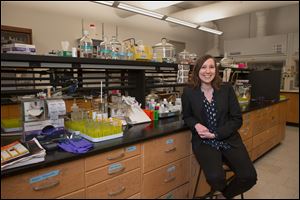
Photoresponsive materials come to light in BGSU laboratory
2/27/2017At my laboratory at Bowling Green State University’s Center for Photochemical Sciences, we are venturing into a new world of materials with properties as yet unknown but that offer the promise of beneficial applications in health, industry, agriculture, and other fields.
The overall goal of my lab is to make photoresponsive materials; those materials have in them metal ions for unique reactivities. By mixing metal ions with polymers, or plastics, and exposing the resulting materials to light, I aim to open up new avenues of discovery. We might make materials with interesting properties we don’t even know yet. This is fundamental research.

The National Science Foundation recently awarded BGSU professor Alexis Ostrowski a CAREER grant of almost $600,000 to fund her research for five years. She also recently was named one of 16 ‘Emerging Investigators in Inorganic Photochemistry and Photophysics’ by the American Chemical Society.
For the last four years, my students and I have conducted research and gathering preliminary data on which to build the foundation for our current project, “Controlling Mechanical Properties of Materials Using Photoactive Metal Coordination Bonds.”
As a chemist, I see the world through a different lens than do nonchemists. A basic difference between chemists and nonchemists is that we tend to think a lot on the molecular level. It all comes back to what are the interactions of the molecules with each other. You want to very selectively control the interactions of those molecules, so you build into the material certain kinds of interactions. And then if we shine light on the material, what does that do? How can we change those interactions to change the mechanical properties of the materials?
Once we gain an understanding of how to manipulate the variables to achieve the desired mechanical properties, it will be a matter of customizing them for specific uses. We are already finding that some materials work better together than others.
Although some biomaterials can be photoresponsive, adding in the metal ions creates much greater potential for these new interactions and responsiveness to light. We are not working with actual hard metals but with metal salts, or ions, which are positively charged and can bind to different substances and participate in different processes.
Likewise, certain polymers can respond to light, but it’s usually UV light. When you add in metal ions, you get a lot more reactivities. You can use more kinds of light and get more varied responses to light. There are more “knobs” you can tune on how the materials can respond to light.
Unlike traditional materials whose reactions to stress, for example, are known, and for which mechanical engineers can build models to predict how they will respond, these new materials will have completely different properties.
So far, the data show the concept works — there are indeed changes in mechanical properties of the new materials.
We can use metal ions to make irreversible changes in polymers so we can pattern in stiff and soft areas in the material, which has health applications. For example, biological tissues in skin or the heart have really different mechanical properties than you can usually make in a lab. They’re called hierarchical materials, with all these layers of complexity. That’s really difficult to mimic with a plastic, so how are you going to do that? You can shine light on a material in certain areas, and make one area softer and one stiffer. We can really easily change and pattern this material with specific “stiffnesses.”
This has implications for tissue engineering. A collaborator of mine, Rhima Coleman and her team at the University of Michigan, who have grown stem cells in these materials, show how those stem cells start to grow differently depending on where they are, in a softer or stiffer environment. Researchers in tissue engineering thus need to grow cells in materials with unique properties.
The other direction relates to another kind of materials that are not biologically related and may be even more challenging. My research could help develop coatings on things such as cars that would be not only scratch resistant but that could be “healed” by shining a light on them.
This would seem to contradict basic rules about materials and the relationships between molecules, along with our knowledge about rigid, hard substances.
This is really difficult to do because when you scratch them, you break apart those bonds. How can we accommodate breaking bonds while maintaining rigidity and strength? The answer may be to soften them selectively with light, using the light to manipulate interactions between the molecules in the novel materials.
All this sounds very high tech, and it is, but some of the ideas are bioinspired. My former colleagues at the University of California at Santa Barbara and at other universities are studying the way in which common mussels attach themselves so firmly to piers and rocks. The mussels, it turns out, have substances in their protein structures that bind to iron ions and create a new material with new properties.
Carl Carrano at San Diego State University is applying the idea to see if brown algae or sea kelp naturally bind to iron ions in water using this same polymer.
There are many examples in in nature of interfaces of inorganic metals with organic polymers and proteins, including how teeth and bones can be both strong and elastic because of the interaction of the hard calcium phosphate and the protein polymers surrounding them.
I suspect that, as the body of knowledge in this area grows, more of these fascinating interactions between metal ions and polymers will come to light.
Alexis Ostrowski, PhD, is an assistant professor of chemistry at Bowling Green State University. Her laboratory investigates the synthesis of inorganic complexes, nanoparticles and polymers that all respond in specific ways to light irradiation. For more information, visit bgsu.edu. The Blade showcases a BGSU science column on the last Monday of every month.